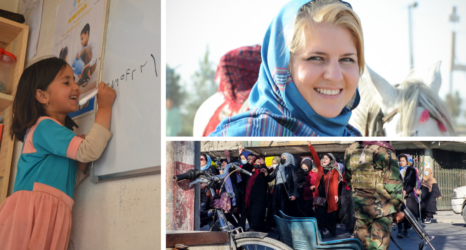The women’s movement is shifting into a new era, and people from around the world are standing in solidarity to ensure all women have access to equal rights. In places like the United States and Europe, which have already seen several decades of women’s empowerment movements, this latest iteration is built on the momentum of women’s rights pioneers before them. In places like Pakistan, Afghanistan and Tajikistan, the women’s movement is just taking hold—and those movements are complicated by years of war, competing tribal beliefs and a history of using violence as punishment for disobedience.
The threat of violence against women is still rampant in many parts of Pakistan and Afghanistan where women and girls are sometimes valued less than their male counterparts. In many conservative areas they are denied access to education and face threats of violence if they defy orders to stay home. Despite United Nations Millennial goals to eliminate gender disparity in primary and secondary education and provide primary schooling to all children, both countries lag far behind in both equality and access to education.
Support for girls’ education can vary between villages, families and generations. Central Asia Institute (CAI), a nonprofit organization dedicated to providing education for women and girls in Pakistan, Afghanistan and Tajikistan, works to support the people and villages who desire education for their girls. They work with partner organizations to provide children in some of the poorest and most remote areas access to education. Surrounding all these schools, there are tales of violence intended to scare the women and their supporters from going to school at all.
Shafia and her husband worked hard to send their daughter to school in a small village in southeast Afghanistan, despite the threat from conservative community members who don’t believe girls need education. Soon after their daughter started grade 6, Shafia and her husband were threatened with their lives if they continued to let their daughter go to school.
The parents knew the threats were real, but their hope for their daughter was stronger. The members of a local militant group made good on their threat, and Shafia’s husband was killed not long after for defying their orders. Her family suspects Shafia’s brother-in-law, who was a staunch conservative with alleged ties to a militant group, was mostly to blame. Fearing for her life and her family, Shafia fled to the outskirts of Kabul where she hoped her father would keep them safe.
She decided her husband would not die in vain. Not only did she enroll her daughter in school, but, at age 20, she enrolled herself. With the help of a scholarship from CAI, she graduated from Kabul University and began working for one of CAI’s in-country partners. In that role she helped hundreds of girls go to school each year.
Unfortunately, Shafia’s story is not unique. For every community that encourages girls to learn, another group is strictly opposed to women’s education and will do anything to keep them home. Their reasons form a tangled web of tribal customs, family traditions, and conflicting interpretations of religious texts. Most of those who are opposed to women’s education have never been to school themselves.
“The threats of violence come from illiterate people,” says Janagha Jaheed, head of one of CAI’s partners in Afghanistan, Marcopolo Social Services and Reconstruction Organization. “They are misguided in thinking they shouldn’t send their girls to school, that it is against Islam.”
Bringing education to rural and isolated villages for the next generation is the only sure-fire way to change the culture from within, but this can be a tricky process. Even when most of the villagers are interested in education, a few vocal and powerful militants can foil efforts using threats and harassment to keep girls home.
Janagha recalls the story of a female teacher who was forced to leave her school because she had both boys and girls in her class. She was the only teacher available to educate the children at the Jamia-Tagab Primary School in the Badakhshan region of Afghanistan. In more conservative areas it’s unacceptable for a woman to teach male students, but there were no male teachers available so the woman risked her life to try and educate all the children. When the Taliban heard she was defying their traditions, they forced her to leave the school saying it wasn’t good for her reputation and there would be repercussions if she didn’t leave.
“She was a very hard working lady, teaching for a long time,” says Janagha. “The commander of the Taliban didn’t allow her to teach.”
Both Pakistan and Afghanistan have enacted laws and protections for women, but implementing these rules is murky, especially in the rural villages far removed from the reach of a central government. These villages depend on tribal customs for livelihood and survival, and traditions and customs don’t often include modern education, especially for girls. While many villages see the benefits of educating girls, others are so steeped in tradition they would rather keep a woman isolated at home under threats of beatings than let her learn in a classroom.
For many of these women, violence is just part of their culture. In a December 2016 report, 80 percent of women in Afghanistan reported experiencing some kind of violence in their lifetimes. The United Nations Gender Equality Index ranks Pakistan 147th out of 188 countries, and violent crimes against women such as beatings, rape, and honor killings are reported in alarming numbers daily.
Both countries have passed laws in recent years to protect women and hold their abusers accountable, but these laws have either been met with fierce criticism from conservative religious groups or have not been readily enforced.
Pakistan’s Punjab Protection of Women Against Violence Act of 2015 was supposed to protect women against the kinds of crimes that keep them from school like domestic violence, stalking, and cyber crimes, but it has been opposed by the same groups who required women to provide four male witnesses to prove rape at court hearings. In Afghanistan the 2009 Elimination of Violence Against Women Act, a presidential decree put in place by Hamid Karzai, is under attack by groups trying to chip away the protections for child brides and victims of domestic violence.
Despite threats of violence that will most likely go unpunished, these women and girls want to be educated. When they can read, they will have the ability to understand the laws and religious texts for themselves. They don’t want to rely on others to interpret their lives for them, and they want the opportunity to help their families and pursue their own livelihoods. Unfortunately, in many poor and rural areas, a woman’s education may seem less valuable than her ability to work in a field or become a wife. If she defies these cultural limitations, she may face beatings by her family, acid attacks, or other horrific acts of violence against her with no protection from law enforcement.
Sometimes conservative groups will use the threat of violence to send a message to an entire village or school instead of singling out one person. If enough women are afraid to go to school or teach at the school, it will shut down by itself.
Wakil Karimi, who manages CAI’s partner organization in Afghanistan, Star of Knowledge (SKO), recalls one incident where implicit threats kept girls from going to school.
“At night they put a coffin [in the schoolyard] and put the head of an animal and a note that said if you let your daughter go to school we will kill your daughter,” Wakil recalls. “They scare the girls to not go to school.”
It’s not just the schools that draw acts of violence in this struggle for the right to provide quality education. Sometimes the people who support education are targeted as well. One of Wakil’s program supervisors from the northern Badakhshan region of Afghanistan witnessed the extent some members of the Taliban will go to intimate those who work for better education.
After a recent training seminar in Kabul, a program supervisor for SKO and her friend were traveling back to Badakhshan by bus. Members of the Taliban stopped the bus and searched all the travelers.
The program supervisor’s companion had a small pamphlet from the training in her bag, and this was unacceptable to the men who had stopped the bus. In a brutal act of violence, he cut the woman’s eyes out and left her as an example. Wakil reports that she is alive and recovering in a hospital, but this is only one example of the kind of violence used to stop women from earning an education.
While situations like these can leave ordinary people feeling helpless that change can ever happen, there are some bright spots and evidence that the situation for women and girls is improving.
Wakil is quick to point out that not all members of the Taliban are against education. He says that many members are beginning to send their own girls to school and have publically declared education important.
Then there are all the girls who are attending schools, earning their degrees, and joining the workforce in jobs previously reserved only for men. In October the Afghan government hired 20 female engineers along with their male counterparts to reconstruct a demolished palace. The women were hired solely based on their merit and skill, beating out some of them men who had applied for the position.
CAI has also seen an increase in requests for scholarships, new schools, boundary walls, and supplies from citizens in Pakistan, Afghanistan, and Tajikistan, who value the importance of educating women. “We get so many letters from people who want a school,” says Wakil.
People in these regions see that education can be the first step out of poverty and into prosperity. Educating women is shown to improve, not only the life of the woman, but everyone around her. Education increases a woman’s earning potential up to 20 percent, meaning she has the chance to raise her family and community out of poverty. Education also increases the age of marriage for a woman and decreases the likelihood her children will die before they reach the age of five.
“The situation is getting better. The violence is less than before,” observes Wakil. “I try to talk to them. I say ‘if your wife gets sick, is it better to take her to a male doctor or a female doctor?’ They are starting to see the benefit of education for everyone.”
More women are pursuing an education and entering the workforce. Sometimes they are the first in their family to do so. They are the pioneers. Many will face opposition in their quest for knowledge. Some will face violence. Yet, like other brave women before them, they are reshaping their countries, serving as role models for younger generations and blazing an indestructible path toward the future.
In Afghanistan and Pakistan, the education revolution has begun. Women are leading the charge—and no amount of threats will stop them.





